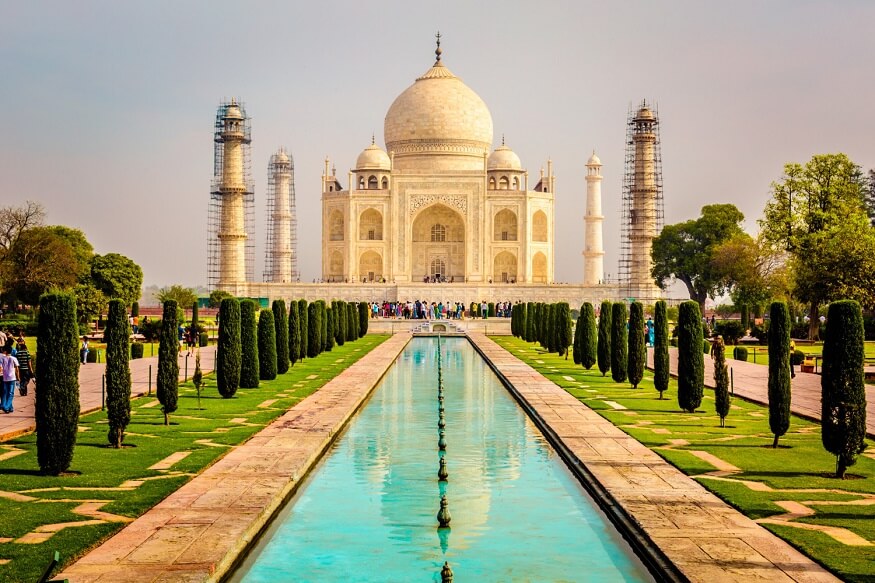India is home to some of the world’s most stunning architectural marvels that speak of the country’s immense diversity in planning over the years. These structures, palaces, caves, temples, and monuments stand testimony to the unparalleled architectural prowess that exists. In this blog, we will take you on a journey through seven of these heritage monuments of India that showcase the country’s diversity in planning and design over the years.
Also Read: The Bronze Age Era and its Empire
1) Taj Mahal, Agra
Constructed in the 17th century, by emperor Shah Jahan, in memory of his wife, the Taj Mahal, is the epitome of Mughal architecture with a mix of Persian, Turkish, Islamic and Indian styles. Ranked among the Seven Wonders of the World, the Taj Mahal’s defining elements include symmetrical structures, extensive use of marble inlays, and intricate floral patterns.
The construction of the Taj Mahal involved 22,000 labourers, stonecutters, embroidery artists, and painters over a span of approximately 20 years. The Taj Mahal is enveloped by an expansive range of gardens. featuring quadrilateral layouts divided by water channels.
2) Qutub Minar, Delhi
A UNESCO World Heritage Site, the Qutub Minar exhibits the Indo-Islamic architectural style that flourished during the Delhi Sultanate period. Its red sandstone and marble structure is decorated with intricate carvings and verses from the Quran.
The pillar has a base diameter of 14.32 metres (47 feet) tapering to 2.75 metres (9 feet) at the top storey. The monument, surrounded by a lush green garden, houses several historically significant structures such as the Quwwat-ul-Islam Mosque, the Tomb of Imam Zamin, and the Iron Pillar, among others.
3) Victoria Memorial, Kolkata, West Bengal
The Victoria Memorial, Kolkata, is an embodiment of architectural excellence. This magnificent edifice, built to honour Queen Victoria of Britain, reflects an exquisite blend of British and Mughal architecture, standing as a symbol of the colonial era’s rich history.
Designed by Sir William Emerson in 1901, this grand marble structure took 15 years of meticulous craftsmanship to reach completion. The Memorial exhibits an Indo-Saracenic architectural style, intertwining aspects of British, Venetian, Egyptian, and traditional Indian styles. Its iconic central dome surrounded by several smaller domes features brilliant hints of Mughal architecture. The Memorial stands approximately 184 feet high, sprawled across a vast expanse of 64 acres, surrounded by lush gardens brilliantly designed following the ‘garden-city movement theory.’
The monument’s chief material is white Makrana marble, renowned for its pure, lustrous finish, acquired from Jodhpur, Rajasthan. The building comprises numerous galleries with a host of paintings and artefacts from the British colonial period, giving visitors a glimpse of the rich Victorian and Indian histories.
Also Read: Why Is History Important and How Can It Benefit Your Future?
4) Khajuraho Temples, Madhya Pradesh
Renowned for their intricate sculptures, the temples of Khajuraho showcase the Nagara style of temple architecture typical of Central India. These temples are particularly famous for their erotic sculptures that represent a celebration of love, life, and worship.
Constructed between 950 and 1050 AD by the Chandela Dynasty, these temples are a perfect blend of science, architecture, and imagination. One notable design element is Nagara-style architecture which is characterised by height and upward movement. The main Sanctum Sanctorum is situated on a plinth and encircled by subsidiary shrines.
The sculptural adornments of the exterior walls and the towering spires, known as shikharas, dramatically point to the sky, giving the illusion of a mountain range which embodies the Hindu philosophical concept of the cosmos.
Another fascinating architectural marvel is the intricate stone carvings that depict various aspects of life, both physical and spiritual. The temples are adorned with thousands of statues and sculptures depicting gods, mythical creatures, war scenes, various forms of yoga, and even daily life activities.
5) Konark Sun Temple, Odisha
A 13th-century marvel, the Konark Sun Temple is designed in the form of a colossal chariot with intricately carved wheels and horses. This UNESCO World Heritage Site represents the Kalinga style of architecture and is one of the grandest examples of craftsmanship in Indian stone carving.
Named after Konarka, the presiding deity of the Sun temple, the temple was constructed by King Narasimhadeva I of the Eastern Ganga Dynasty around A.D. 1250. The design of the temple hints towards the sun god’s celestial journey across the heavens. Twelve giant wheels, each measuring 10 feet in diameter, adorn the sides of the temple – symbolising the twelve months of a year. Each wheel is intricately carved, and the shadows cast by the spokes provide a sundial effect.
The most enchanting feature of the Konark Sun Temple, however, is the array of human, divine, and animal figures that are carved with precision. From scenes of everyday life to divine intervention, from blossoming romances to fearsome battles – all of human life, and indeed, much beyond it, is played out in the detailed stonework.
Also Read: 10 interesting ways to learn history
6) Mysore Palace, Karnataka
Constructed in 1912, Mysore Palace is an amalgamation of Hindu, Muslim, Rajput, and Gothic architectural styles. The three-storeyed stone palace is known for its elaborately carved entrances and domes, emphasising the Indo-Saracenic architectural style.
The principal building, made up of three stories, is made from grey granite with deep pink marble domes. The palace is enclosed by a large garden, enhancing the sumptuous experience of the place.
The south facade of the palace exhibits seven expansive arches, and two smaller ones flanking the central arch, which accommodates the majestic Durbar Hall. The Durbar Hall, also known as the ‘Kalyana Mantapa,’ is the palace’s crowning glory. With its colossal octagonal-shaped dome, the room is embellished with glass chandeliers and stained-glass ceilings depicting scenes from Indian epics.
7) Ajanta and Ellora Caves, Maharashtra
Dated between the 2nd century BC and 6th century AD, these rock-cut complexes, housing some of the best murals, sculptures, and frescoes, epitomise the brilliance of ancient Indian rock-cut architecture.
Also Read: What is a pyramid: History of egyptian pyramid and construction
Conclusion
Each of these architectural masterpieces offers a glimpse into India’s rich history, diverse culture, and architectural talent. They stand testimony to the various eras, and the progression in architectural expression and planning over the centuries.










